Tal Ben-Nun
Modeling Code: Is Text All You Need?
Jul 15, 2025Abstract:Code LLMs have become extremely popular recently for modeling source code across a variety of tasks, such as generation, translation, and summarization. However, transformer-based models are limited in their capabilities to reason through structured, analytical properties of code, such as control and data flow. Previous work has explored the modeling of these properties with structured data and graph neural networks. However, these approaches lack the generative capabilities and scale of modern LLMs. In this work, we introduce a novel approach to combine the strengths of modeling both code as text and more structured forms.
Leveraging AI for Productive and Trustworthy HPC Software: Challenges and Research Directions
May 13, 2025Abstract:We discuss the challenges and propose research directions for using AI to revolutionize the development of high-performance computing (HPC) software. AI technologies, in particular large language models, have transformed every aspect of software development. For its part, HPC software is recognized as a highly specialized scientific field of its own. We discuss the challenges associated with leveraging state-of-the-art AI technologies to develop such a unique and niche class of software and outline our research directions in the two US Department of Energy--funded projects for advancing HPC Software via AI: Ellora and Durban.
BOOM: Benchmarking Out-Of-distribution Molecular Property Predictions of Machine Learning Models
May 03, 2025Abstract:Advances in deep learning and generative modeling have driven interest in data-driven molecule discovery pipelines, whereby machine learning (ML) models are used to filter and design novel molecules without requiring prohibitively expensive first-principles simulations. Although the discovery of novel molecules that extend the boundaries of known chemistry requires accurate out-of-distribution (OOD) predictions, ML models often struggle to generalize OOD. Furthermore, there are currently no systematic benchmarks for molecular OOD prediction tasks. We present BOOM, $\boldsymbol{b}$enchmarks for $\boldsymbol{o}$ut-$\boldsymbol{o}$f-distribution $\boldsymbol{m}$olecular property predictions -- a benchmark study of property-based out-of-distribution models for common molecular property prediction models. We evaluate more than 140 combinations of models and property prediction tasks to benchmark deep learning models on their OOD performance. Overall, we do not find any existing models that achieve strong OOD generalization across all tasks: even the top performing model exhibited an average OOD error 3x larger than in-distribution. We find that deep learning models with high inductive bias can perform well on OOD tasks with simple, specific properties. Although chemical foundation models with transfer and in-context learning offer a promising solution for limited training data scenarios, we find that current foundation models do not show strong OOD extrapolation capabilities. We perform extensive ablation experiments to highlight how OOD performance is impacted by data generation, pre-training, hyperparameter optimization, model architecture, and molecular representation. We propose that developing ML models with strong OOD generalization is a new frontier challenge in chemical ML model development. This open-source benchmark will be made available on Github.
Trajectory Balance with Asynchrony: Decoupling Exploration and Learning for Fast, Scalable LLM Post-Training
Mar 24, 2025Abstract:Reinforcement learning (RL) is a critical component of large language model (LLM) post-training. However, existing on-policy algorithms used for post-training are inherently incompatible with the use of experience replay buffers, which can be populated scalably by distributed off-policy actors to enhance exploration as compute increases. We propose efficiently obtaining this benefit of replay buffers via Trajectory Balance with Asynchrony (TBA), a massively scalable LLM RL system. In contrast to existing approaches, TBA uses a larger fraction of compute on search, constantly generating off-policy data for a central replay buffer. A training node simultaneously samples data from this buffer based on reward or recency to update the policy using Trajectory Balance (TB), a diversity-seeking RL objective introduced for GFlowNets. TBA offers three key advantages: (1) decoupled training and search, speeding up training wall-clock time by 4x or more; (2) improved diversity through large-scale off-policy sampling; and (3) scalable search for sparse reward settings. On mathematical reasoning, preference-tuning, and automated red-teaming (diverse and representative post-training tasks), TBA produces speed and performance improvements over strong baselines.
Lion Cub: Minimizing Communication Overhead in Distributed Lion
Nov 25, 2024Abstract:Communication overhead is a key challenge in distributed deep learning, especially on slower Ethernet interconnects, and given current hardware trends, communication is likely to become a major bottleneck. While gradient compression techniques have been explored for SGD and Adam, the Lion optimizer has the distinct advantage that its update vectors are the output of a sign operation, enabling straightforward quantization. However, simply compressing updates for communication and using techniques like majority voting fails to lead to end-to-end speedups due to inefficient communication algorithms and reduced convergence. We analyze three factors critical to distributed learning with Lion: optimizing communication methods, identifying effective quantization methods, and assessing the necessity of momentum synchronization. Our findings show that quantization techniques adapted to Lion and selective momentum synchronization can significantly reduce communication costs while maintaining convergence. We combine these into Lion Cub, which enables up to 5x speedups in end-to-end training compared to Lion. This highlights Lion's potential as a communication-efficient solution for distributed training.
VENOM: A Vectorized N:M Format for Unleashing the Power of Sparse Tensor Cores
Oct 03, 2023



Abstract:The increasing success and scaling of Deep Learning models demands higher computational efficiency and power. Sparsification can lead to both smaller models as well as higher compute efficiency, and accelerated hardware is becoming available. However, exploiting it efficiently requires kernel implementations, pruning algorithms, and storage formats, to utilize hardware support of specialized sparse vector units. An example of those are the NVIDIA's Sparse Tensor Cores (SPTCs), which promise a 2x speedup. However, SPTCs only support the 2:4 format, limiting achievable sparsity ratios to 50%. We present the V:N:M format, which enables the execution of arbitrary N:M ratios on SPTCs. To efficiently exploit the resulting format, we propose Spatha, a high-performance sparse-library for DL routines. We show that Spatha achieves up to 37x speedup over cuBLAS. We also demonstrate a second-order pruning technique that enables sparsification to high sparsity ratios with V:N:M and little to no loss in accuracy in modern transformers.
Cached Operator Reordering: A Unified View for Fast GNN Training
Aug 23, 2023Abstract:Graph Neural Networks (GNNs) are a powerful tool for handling structured graph data and addressing tasks such as node classification, graph classification, and clustering. However, the sparse nature of GNN computation poses new challenges for performance optimization compared to traditional deep neural networks. We address these challenges by providing a unified view of GNN computation, I/O, and memory. By analyzing the computational graphs of the Graph Convolutional Network (GCN) and Graph Attention (GAT) layers -- two widely used GNN layers -- we propose alternative computation strategies. We present adaptive operator reordering with caching, which achieves a speedup of up to 2.43x for GCN compared to the current state-of-the-art. Furthermore, an exploration of different caching schemes for GAT yields a speedup of up to 1.94x. The proposed optimizations save memory, are easily implemented across various hardware platforms, and have the potential to alleviate performance bottlenecks in training large-scale GNN models.
STen: Productive and Efficient Sparsity in PyTorch
Apr 15, 2023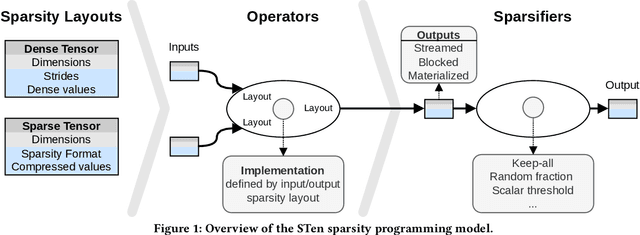
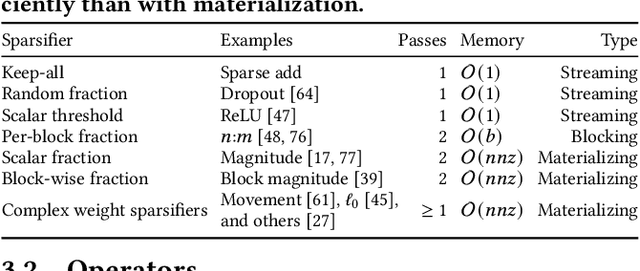
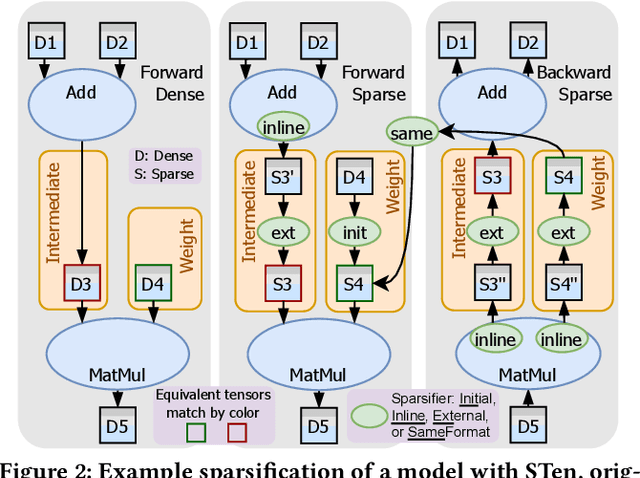
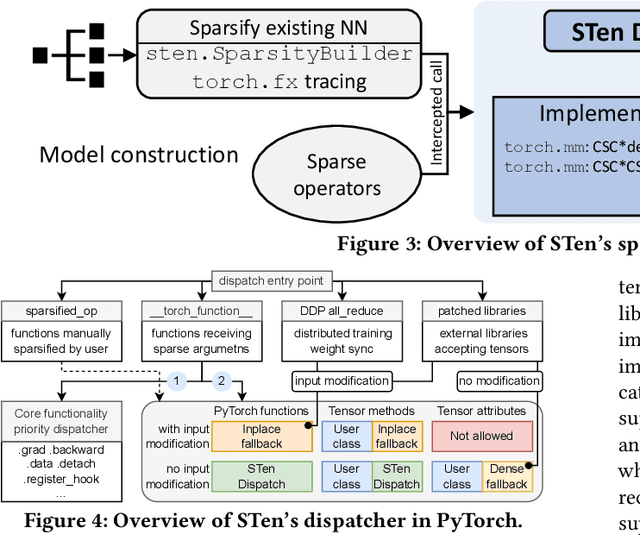
Abstract:As deep learning models grow, sparsity is becoming an increasingly critical component of deep neural networks, enabling improved performance and reduced storage. However, existing frameworks offer poor support for sparsity. Specialized sparsity engines focus exclusively on sparse inference, while general frameworks primarily focus on sparse tensors in classical formats and neglect the broader sparsification pipeline necessary for using sparse models, especially during training. Further, existing frameworks are not easily extensible: adding a new sparse tensor format or operator is challenging and time-consuming. To address this, we propose STen, a sparsity programming model and interface for PyTorch, which incorporates sparsity layouts, operators, and sparsifiers, in an efficient, customizable, and extensible framework that supports virtually all sparsification methods. We demonstrate this by developing a high-performance grouped n:m sparsity layout for CPU inference at moderate sparsity. STen brings high performance and ease of use to the ML community, making sparsity easily accessible.
Performance Embeddings: A Similarity-based Approach to Automatic Performance Optimization
Mar 14, 2023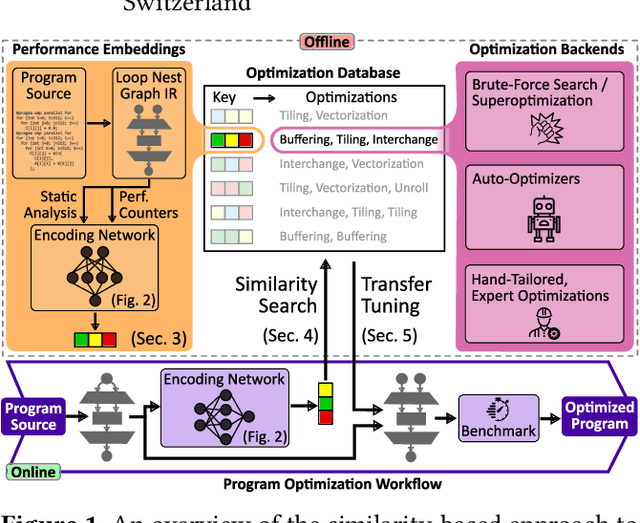
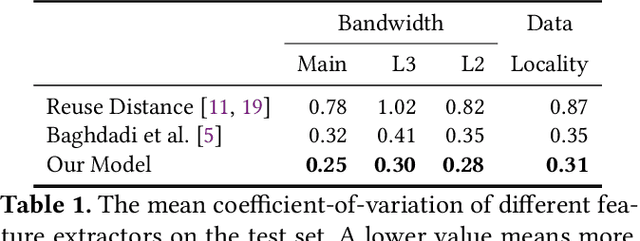

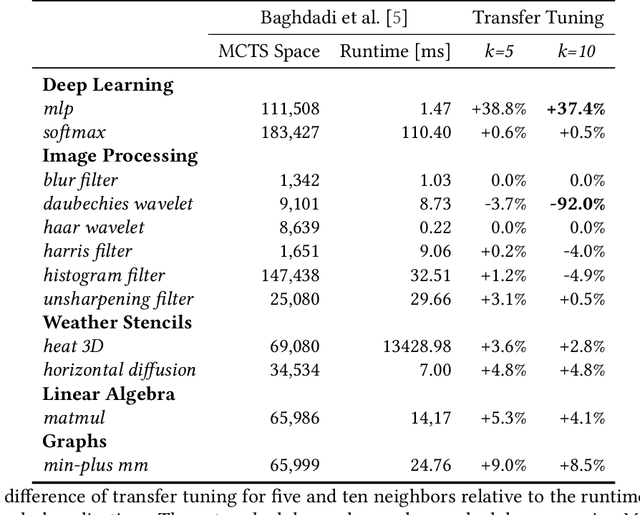
Abstract:Performance optimization is an increasingly challenging but often repetitive task. While each platform has its quirks, the underlying code transformations rely on data movement and computational characteristics that recur across applications. This paper proposes to leverage those similarities by constructing an embedding space for subprograms. The continuous space captures both static and dynamic properties of loop nests via symbolic code analysis and performance profiling, respectively. Performance embeddings enable direct knowledge transfer of performance tuning between applications, which can result from autotuning or tailored improvements. We demonstrate this transfer tuning approach on case studies in deep neural networks, dense and sparse linear algebra compositions, and numerical weather prediction stencils. Transfer tuning reduces the search complexity by up to four orders of magnitude and outperforms the MKL library in sparse-dense matrix multiplication. The results exhibit clear correspondences between program characteristics and optimizations, outperforming prior specialized state-of-the-art approaches and generalizing beyond their capabilities.
A Theory of I/O-Efficient Sparse Neural Network Inference
Jan 03, 2023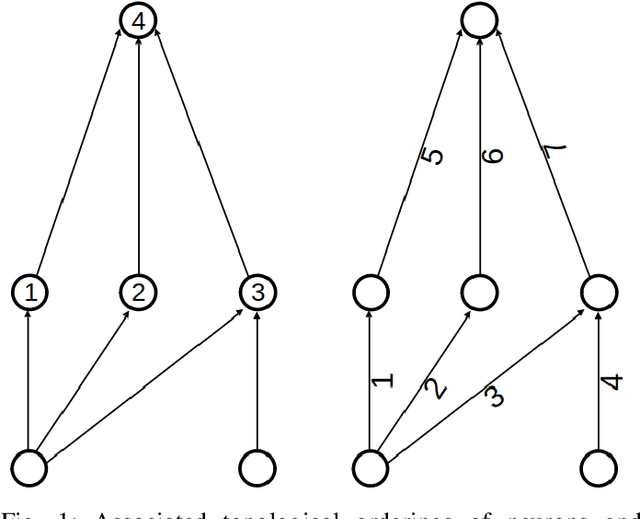
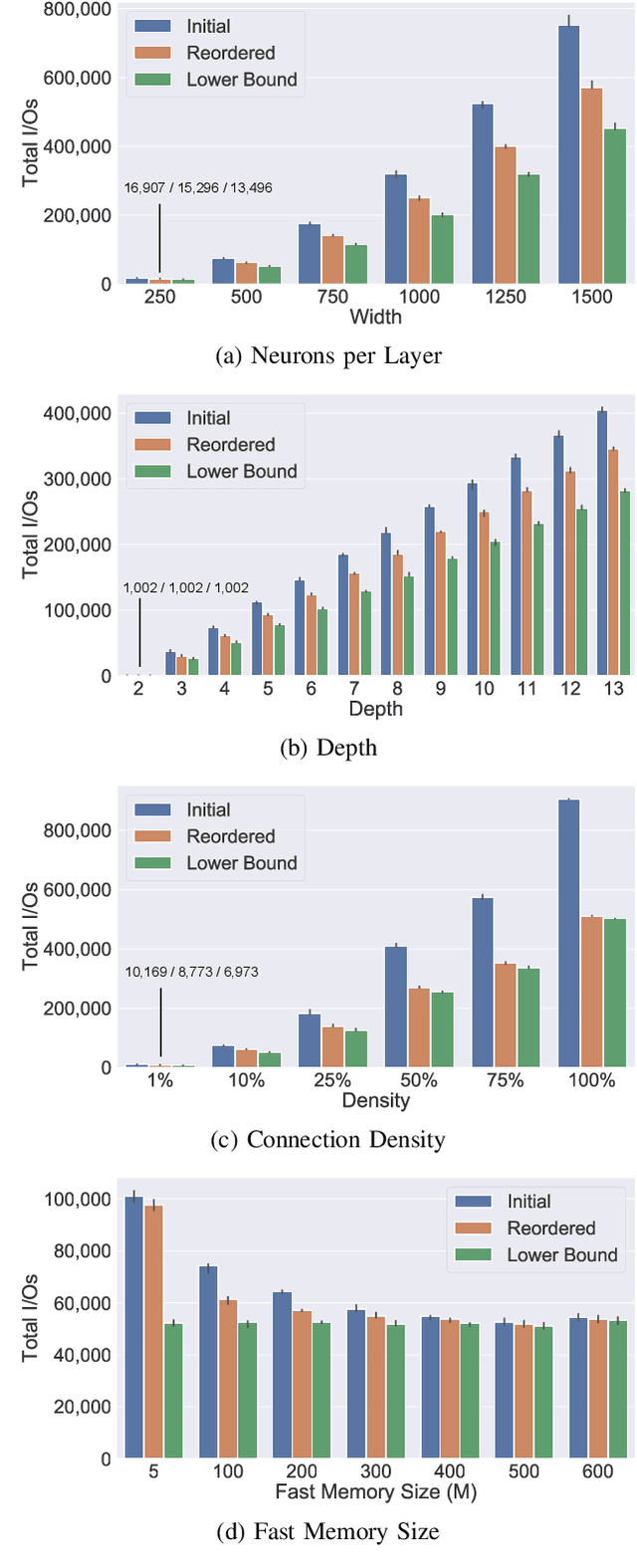
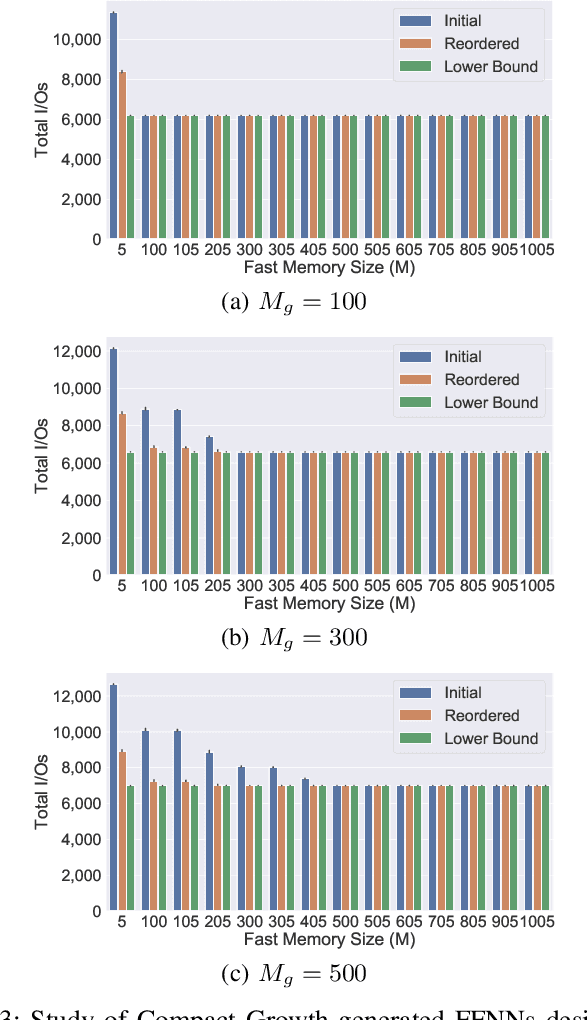
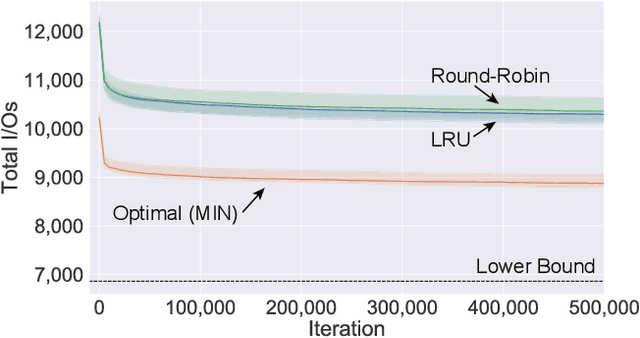
Abstract:As the accuracy of machine learning models increases at a fast rate, so does their demand for energy and compute resources. On a low level, the major part of these resources is consumed by data movement between different memory units. Modern hardware architectures contain a form of fast memory (e.g., cache, registers), which is small, and a slow memory (e.g., DRAM), which is larger but expensive to access. We can only process data that is stored in fast memory, which incurs data movement (input/output-operations, or I/Os) between the two units. In this paper, we provide a rigorous theoretical analysis of the I/Os needed in sparse feedforward neural network (FFNN) inference. We establish bounds that determine the optimal number of I/Os up to a factor of 2 and present a method that uses a number of I/Os within that range. Much of the I/O-complexity is determined by a few high-level properties of the FFNN (number of inputs, outputs, neurons, and connections), but if we want to get closer to the exact lower bound, the instance-specific sparsity patterns need to be considered. Departing from the 2-optimal computation strategy, we show how to reduce the number of I/Os further with simulated annealing. Complementing this result, we provide an algorithm that constructively generates networks with maximum I/O-efficiency for inference. We test the algorithms and empirically verify our theoretical and algorithmic contributions. In our experiments on real hardware we observe speedups of up to 45$\times$ relative to the standard way of performing inference.
 Add to Chrome
Add to Chrome Add to Firefox
Add to Firefox Add to Edge
Add to Edge